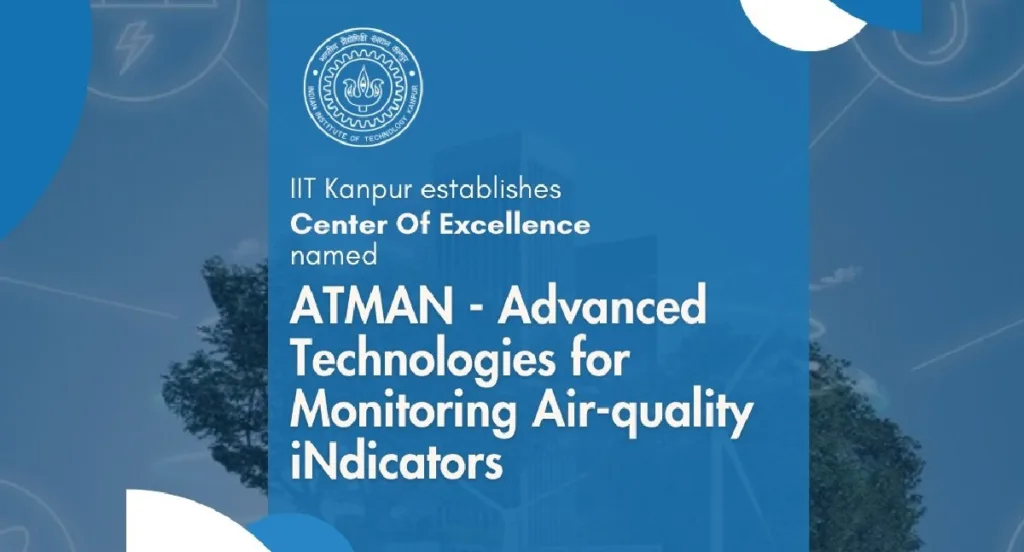The Indian Institute of Technology Kanpur (IIT-K) is taking a groundbreaking step towards enhancing air quality in both urban and rural areas of India with the establishment of the Centre of Excellence (CoE) named ATMAN, which stands for “Advanced Technologies for Monitoring Air-quality iNdicators.” This initiative is aligned with the Atma Nirbhar Bharat campaign, a government initiative aimed at achieving self-reliance, particularly in the field of air quality monitoring.
Backed by generous organizations like Bloomberg Philanthropies, Open Philanthropy, and the Clean Air Fund, ATMAN is determined to tackle India’s urgent air quality issues through advanced technology. This endeavor aligns closely with the vision of India’s Principal Scientific Advisor, who aims to transform sustainable technologies and business concepts into practical solutions accessible to millions worldwide.
Prof. S Ganesh, Officiating Director of IIT Kanpur, expressed the institute’s dedication to combating air pollution through ATMAN. He emphasized the meticulous evaluation of health risks associated with air pollutants and a comprehensive review of air quality standards.
ATMAN is currently working on several projects, each designed to revolutionize air quality monitoring in India.
AMRIT (Ambient Air Quality Monitoring of Rural Areas using Indigenous Technology) is a groundbreaking initiative that entails the extensive deployment of a Sensor Ambient Air Quality Monitor (SAAQM) network comprising 1,400 nodes in the rural regions of Bihar and Uttar Pradesh. This initiative represents a groundbreaking endeavor to offer all-encompassing air quality monitoring in regions that have traditionally faced a shortage of adequate air quality information. ATMAN is working in partnership with both the State Pollution Control Board of Bihar and the Department of Environment, Forests & Climate Change of Uttar Pradesh to enhance air quality management within these states.
DHSA (Dynamic Hyper-local Source Apportionment): ATMAN is pioneering a cost-effective approach to source apportionment in Lucknow and Kanpur in Uttar Pradesh. This innovative method will provide city authorities with data-driven insights to make informed decisions in their air quality action planning. The long-term vision is to scale DHSA systems across cities in the country to dynamically inform about emission and sources of air pollution.
PM2.5 Prediction and Airshed Management: This project utilizes micro-satellite imagery, sensor-based ambient air quality networks, and machine learning to predict PM2.5 levels at finer resolutions. Additionally, the CoE is developing an airshed approach to address air pollution on a larger scale with data-driven policy decisions.
Prof. Ajay Sood, Principal Scientific Adviser to the government, highlighted the global scalability of ATMAN’s projects, thanks to indigenous sensor manufacturing. These projects promise to revolutionize air quality monitoring and management, not only within India but also on a global scale.
Prof. Sachchidanand Tripathi, who heads the Centre of Excellence (CoE), expressed enthusiasm for the impactful research underway. He noted that ATMAN is leading the infusion of Indigenous Technology towards an Atmanirbhar Bharat, emphasizing the importance of collaboration with state government departments in Bihar and Uttar Pradesh to bridge the gap in data-driven Air Quality Management (AQM) policy.
The inception of ATMAN marks a notable stride in India’s efforts to address air pollution and enhance the well-being of its populace. Thanks to its state-of-the-art technology and pioneering initiatives, ATMAN is well-positioned to leave an enduring imprint on air quality surveillance, not only within India but also on a global scale.
Direct Link: Centre of Excellence ATMAN

